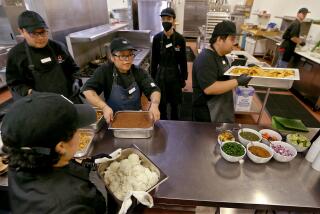Turkey and Yams -- All of It Weightless
- Share via
HOUSTON — Vickie Kloeris would like nothing more than to suffer the traditional anxieties of Thanksgiving: Will the turkey be moist? Will the in-laws get along? But it’s hard to concentrate on such mundane matters when you’ve got things on your mind like giving your soup enough viscosity so that it sticks to a spoon without benefit of gravity.
As the manager of NASA’s space food systems laboratory, Kloeris is in charge of the agency’s cuisine, including the irradiated turkey and thermostabilized, candied yams that two astronauts will get to tear into today, 240 miles overhead aboard the international space station.
“They’ll lay out a pretty good spread for Thanksgiving,” said John McCullough, a NASA flight director.
Of the thousands of tasks performed at Houston’s Johnson Space Center, few are as curious as those undertaken by Kloeris and her staff.
They are, first and foremost, chefs.
On a recent afternoon inside the laboratory-cum-kitchen, two of Kloeris’ assistants were dicing water chestnuts and discussing the virtues of the cumin. NASA’s gumbo and apricot cobbler are loosely based on the family recipes of food scientists Connie Oertli and Donna Nabors, respectively. Kloeris too is an expert cook at home; her husband, she reports, fancies her lasagna.
But the three women are also scientists.
Kloeris, who has been at NASA since 1985, has an undergraduate degree in microbiology and a master’s degree in food science from Texas A&M; University. She and her staff are fluent in World Health Organization formulas for determining salt content and counting calories.
But they must fold into their cooking considerations unnecessary to the earth-bound. Salt and pepper, for instance, can’t be served in shakers because in space, the contents would scatter before making it onto the food. So each gets mixed with liquid -- salt with water and pepper with olive oil -- and placed in squeeze bottles. Astronauts then swab the mixture on.
Crumbs are also taboo.
In microgravity, they would float forever. If enough crumbs built up, they could clog air filters or pose contamination risks.
So food must be designed with precision. Bread is baked so that each piece is surrounded in crust, to avoid flaking. And crackers are baked into bite-sized pieces, so they are never broken outside the astronauts’ mouths.
Preparing the food for astronauts aboard the space station often begins a year before it is to be eaten. Finished meals are shipped aboard Russian supply vehicles; the latest batch arrived in October, along with the space station’s new two-man crew, astronaut C. Michael Foale and cosmonaut Alexander Yurievich Kaleri. The meals must be able to survive for months without refrigeration.
“It’s a niche,” Kloeris said. “That’s for sure.”
Astronauts’ food was once an afterthought, consisting largely of dried, flavored chunks that resembled bullion cubes. Today, giving space travelers some comforts of home -- even if it’s freeze-dried and reconstituted broccoli au gratin -- is considered critical for maintaining a positive environment among the astronaut corps, NASA officials said.
“We try to incorporate texture and color in the food,” Oertli said. “It’s part of what makes food interesting and real. They can’t get fresh food up there, so the more colorful and appetizing it looks, the more it makes the crew happy. It’s important for the psychology up there.”
Before the space station, flights that lasted for just a couple weeks were considered long. Foale and Kaleri are scheduled to remain on the international space station for 192 days.
Such a mission often is the culmination of years of anticipation and training for the astronauts, but that doesn’t make the time and distance any easier, NASA officials say. Holidays are especially hard, and engineers on the ground take great pains to make them special.
In addition to treats like private videoconferences with family members, there is the holiday fare. Foale said he’s building his Thanksgiving feast around the smoked turkey slices he has stockpiled.
But even today’s space-age food formulas won’t cut it as NASA looks beyond the heights reached by the shuttles and the space station -- all the way, some believe, to Mars.
NASA’s best estimates are that such a trip might take five years. Since most food designed for space travel doesn’t have a shelf life longer than one year, new approaches are being explored -- such as growing crops on a spaceship.
Toward that end, Kloeris’ staff has a new task -- testing the shelf life of foods under a variety of conditions.
Those sorts of topics will give way to a simpler pleasure on the space station today. Foale said he would “remember all the good things in life” during dinner.
More to Read
Eat your way across L.A.
Get our weekly Tasting Notes newsletter for reviews, news and more.
You may occasionally receive promotional content from the Los Angeles Times.











